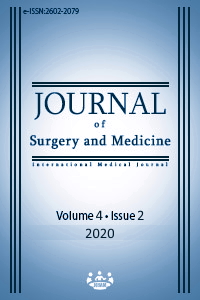Effect of saline flush on the onset time of sugammadex: A randomized clinical study
Keywords:
Saline solution, Neuromuscular block, Train-of-four monitoring, SugammadexAbstract
Aim: Several methods have been tried out to shorten the onset time of sugammadex. The objective of this study was to examine the effect of 20 mL saline flush administered immediately after sugammadex on its onset time by using train-of-four (TOF) monitoring.
Methods: This study was initiated after obtaining the approval of the institutional Medical Research Ethics Committee. A total of 60 ASA I-II patients aged between 18-65 years scheduled for elective abdominal surgery in our hospital between August 2017 and January 2018, which would last 1-3 hours under general anesthesia, were enrolled in this study. Patients were randomly divided into two groups as Group S (saline flush group, n=30) and Group C (control group, n=30). Saline flush group received 2 mg/kg sugammadex and 20 ml isotonic saline flush immediately after sugammadex administration, while the control group received 2 mg/kg sugammadex only. TOF monitoring was used to assess neuromuscular block. Electrocardiography, oxygen saturation, noninvasive arterial pressure as well as acceleromyography values measured by TOF monitoring device were recorded and compared between the groups. All patients were continuously monitored intraoperatively and 30 minutes postoperatively.
Results: Both groups were similar in terms of basic clinical characteristics and demographics. There was a statistically significant difference between the groups in terms of the time of TOF to reach 0.9 from 0.2. The mean time of TOF to reach 0.9 from 0.2 was lower in Saline flush group than in control group (85.4 vs 130.5 seconds; P=0.001).
Conclusion: Our study demonstrated that 20 mL saline flush administered immediately after sugammadex shortened the onset time of sugammadex.
Downloads
References
Esteves S, Martins M, Barros F, Barros F, Canas M, Vitor P, et al. Incidence of postoperative residual neuromuscular blockade in the postanaesthesia care unit: an observational multicentre study in Portugal. Eur J Anaesthesiol. 2013;30:243-9.
Gaszynski T, Szlachcinski L, Jakubiak J, Gaszynski W. Reversal from non-depolarising neuromuscular blockade in the postoperative period. Anestezjol Intens Ter. 2009;41:11-5.
Saager L, Maiese EM, Bash LD, Meyer TA, Minkowitz H, Groudine S, et al. Incidence, risk factors, and consequences of residual neuromuscular block in the United States: The prospective, observational, multicenter RECITE-US study. J Clin Anesth. 2018;55:33-41.
Gaszynski T, Szewczyk T, Gaszynski W. Randomized comparison of sugammadex and neostigmine for reversal of rocuronium-induced muscle relaxation in morbidly obese undergoing general anaesthesia. Br J Anaesth. 2012;108:236-9.
Han TH, Martyn JA. Onset and effectiveness of rocuronium for rapid onset of paralysis in patients with major burns: priming or large bolus. Br J Anaesth. 2009;102:55-60.
Neumar RW, Otto CW, Link MS, Kronick SL, Shuster M, Callaway CW, et al. Part 8: adult advanced cardiovascular life support: 2010 American Heart Association Guidelines for Cardiopulmonary Resuscitation and Emergency Cardiovascular Care. Circulation. 2010;122:S729-67.
Ishigaki S, Masui K, Kazama T. Saline Flush After Rocuronium Bolus Reduces Onset Time and Prolongs Duration of Effect: A Randomized Clinical Trial. Anesth Analg. 2016;122:706-11.
Germano Filho PA, Cavalcanti IL, Barrucand L, Verçosa N. Effect of magnesiumsulphate on sugammadex reversal time for neuromuscular blockade: a randomised controlled study. Anaesthesia. 2015;70: 956-61.
Magorian T, Flannery KB, Miller RD. Comparison of rocuronium, succinylcholine, and vecuronium for rapid-sequence induction of anesthesia in adult patients. Anesthesiology. 1993;79:913-8.
Komatsu R, Nagata O, Ozaki M, Sessler DI. Ephedrine fails to accelerate the onset of neuromuscular block by vecuronium. Anesth Analg. 2003;97:480-3.
Kulkarni M, Chuchendra LS, Bhavya PJ. The Role of Bolus Injection of Saline with Arm Elevation on Rocuronium onset Time: A Randomized Control Study. Anesth Essays Res. 2018;12:55-9.
Emerman CL, Pinchak AC, Hancock D, Hagen JF. The effect of bolus injection on circulation times during cardiac arrest. Am J Emerg Med. 1990;8:190-3.
Nitahara K, Sugi Y, Shigematsu K, Kusumoto G, Abe S, Higa K. Effect of bolus injection of 20 ml saline with arm elevation on the onset time of vecuronium administered via a peripheral vein: a randomised controlled trial. Anaesthesia. 2013;68:904-7.
Iwasaki H, Igarashi M, Kawana S, Namiki A. Accelerated onset of vecuronium neuromuscular block with pulmonary arterial administration. Can J Anaesth. 1994;41:1178-80.
Della Rocca G, Pompei L. A novel approach to reversal of neuromuscular blockade. Minerva Anestesiol. 2009;75:349-51.
Mete A, Karaduman S, Sungurtekin H, Kılıç O. Comparison of sugammadex vs. neostigmine use in recovery of muscle relaxation related to vecuronium in obesity surgery. J Surg Med. 2019;3:307-10.
Jones RK, Caldwell JE, Brull SJ, Soto RG. Reversal of profound rocuronium-induced blockade with sugammadex: a randomized comparison with neostigmine. Anesthesiology. 2008;109:816-24.
Blobner M, Eriksson LI, Scholz J, Motsch J, Della Rocca G, Prins ME. Reversal of rocuronium-induced neuromuscular blockade with sugammadex compared with neostigmine during sevoflurane anaesthesia: results of a randomised, controlled trial. Eur J Anaesthesiol. 2010;27:874-81.
Shields M, Giovannelli M, Mirakhur RK, Moppett I, Adams J, Hermens Y. Org 25969 (sugammadex), a selective relaxant binding agent for antagonism of prolonged rocuronium-induced neuromuscular block. Br J Anaesth. 2006;96:36-43.
Downloads
- 482 972
Published
Issue
Section
How to Cite
License
Copyright (c) 2020 Hamit Yoldaş, İbrahim Karagöz
This work is licensed under a Creative Commons Attribution-NonCommercial-NoDerivatives 4.0 International License.
















